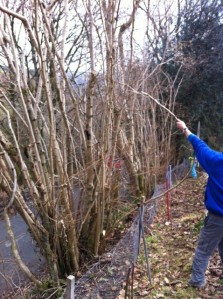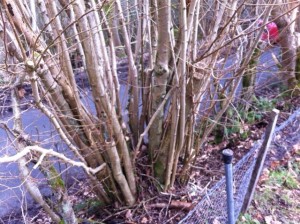It isn’t that often that a Development Officer gets to visit one of their groups and take part in a day of practical environmental improvements; a standard group usually involves sitting and discussing new ideas or walking around to see project work. It is always nice to visit our groups but there is always a part of us that secretly wants to join in, that inner part of a Development Officer that wants to get our hands dirty with the rest of the volunteers. Recently I took the opportunity to do just that.
It was a bright and early start on a Saturday morning in the middle of February, I was getting quite excited, personally this does actually happen quite easily, for example, I received an empty wooden wine crate last Christmas; which would be brilliant for salting hams, I could not contain the inner excited child that never seems to leave a person.
Today I was extra excited for two reasons, I was going to Glyn Ceiriog to visit the Garth Hillside Organic Garden, a community garden project run along the principles of organic permaculture; which is reason in itself to bring a smile to my face but I was also going to take part in a hedge-laying training day. Sharp tools, practical conservation work, fresh air, good company and plenty of cake; this was a dream come true!
The Garth Hillside Organic Garden is a wonderful project to visit; it is a community garden in the beautiful Ceiriog Valley. Despite being 300metres up on an exposed hillside the group grow food year round and follow organic permaculture principles. The site was until a few years ago a steep scrubby field with lots of stones and no facilities, it is still just as steep but now is clear of gorse, the stones have been used to create paths, has raised beds full of vegetables, a compost toilet and an active apiary, the groups aim is to be as holistic and sustainable as possible.
The aim of the day was to learn how to lay an overgrown hedge on the boundary of their site; this would provide an effective barrier to the edge of their garden, improve the hedge as a wildlife corridor and prolong the life of the hedge by encouraging regrowth through the removal of old dead wood and coppicing. I had brought along an old billhook that I had been given as a present a few months ago and I was itching to get stuck in.
There were 7 participants on the course, 2 members of staff Jude and Charlotte, 5 volunteers including myself and our trainer Chris. We introduced ourselves and over a panad and some delicious walnut cake, we got familiar with the tools we were to use; the objectives of the day and some background to the craft of hedge laying.
The hedge in question was a mixture of hazel, holly, ash, elder and hawthorn, the first job was to assess the hedge for dangerous trees and hanging branches then clear the accumulated dead material at the base of the old overgrown tree stumps, removing any dead upright growth; this would encourage new growth and let the light penetrate to the ground.
Once this was done the next step was to lay the trees by cutting almost all of the way through the living stem which is known as the “pleacher”, leaving a thin strip of sapwood and bark to allow the pleacher to remain attached and continue to supply water and nutrients to the leaves to allow growth. It all sounded easier said than done, which we discovered when the first hawthorn pleacher we started to lay snapped off unexpectedly to our disappointment; Chris remarked that we didn’t have to worry as the stump would now coppice well.
In detail, the felling cut is made by sawing through the pleacher almost all of the way and then chopping out the wood above the cut, in this way the pleacher can then naturally lean and be bent towards the ground without splitting. The strip of remaining sapwood faces the ground and the exposed heartwood and stump is exposed to the light which encourages regrowth. As more of the hedge is laid in this way it is woven together and held in place with stakes cut from the hedge, it is then trimmed so it is neat and tidy.
Time flies when you are having fun is the old adage, especially so when you are working outdoors and it was lunch time before we knew it. We stopped and sat looking down the Ceirog Valley from our viewpoint of the groups meeting area, homemade soup with home baked bread and cheese filled the gap nicely, we were joined by a friendly crumb stealing robin with no table manner whatsoever, finding a perch on top of a walnut which was decorating the top of our cake.
By the end of the afternoon we had laid a large section of the hedge, none of us really wanted to stop but as the day was coming to an end we packed up our tools and admired with a certain degree of pride the freshly laid hedge. With luck a well laid hedge will last a long time, grow thickly and form an effective boundary to a site whilst also provide a natural corridor for wildlife.



